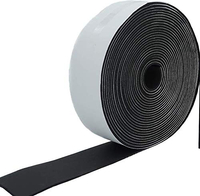Far from an old wives’ tale, experts claim that letting an outside faucet drip throughout the winter months could be the very thing that saves you from frozen pipes and hours of painstaking defrosting or repair work. Here, we have broken down why leaving outside faucets dripping can help prevent frozen faucets and cracked pipes.
Should I let my outdoor faucet drip to prevent it from freezing?
Leaving an outdoor faucet dripping in winter can prevent freezing throughout winter; according to the experts at PlumbNation (opens in new tab), running water is a lot less likely to freeze than stagnant: ‘One way to avoid frozen pipes is to run your taps for short intervals. Water can’t freeze as long as it is moving. A small amount of running water can also relieve pressure inside your internal pipes and prevent over-expansion.’ You can set your faucet to drip while winterizing a house. ‘The key area to concentrate on is outside pipework where they are exposed to elements of the cold; don’t forget to cover bends, valves, and fittings with insulation, too,’ suggests Jess Steele, heating technology expert at BestHeating (opens in new tab). ‘You should also consider pipes located in colder areas of your home like unused garage space where there is no warm air flow.’
How to know if your outside faucet has frozen
A burst or frozen pipe has the same signs outside your home as inside, with no running water the first sign of a problem with your pipework. ‘If you suspect your pipes are frozen the tell-tale signs to look out for include little to no water coming from taps, exposed pipes appearing frosty or wet, and damp patches on walls,’ says Jess Steele of BestHeating. ‘If you spot these signs turn the water off at the valve and run the remaining water to relieve the pressure.’ If you suspect a pipe has burst due to over-expansion from freezing, it is a good idea to call in a professional to prevent further damage, Jess advises. ‘You should temporarily mend the pipe with heavy-duty tape when possible, but always refer to a qualified plumber to fix the issue,’ she says.
When to drip outside faucets
Knowing when to drip faucets is the most important part of protecting an outside faucet from freezing in winter. Get the timing wrong and you could be dealing with over-expanded pipework in no time. ‘You should aim to drip your faucets when outside temperatures begin to sink below 28ºF for three hours or more at a time,’ says Rachel Crow, gardens editor for Homes & Gardens. ‘At the end of fall and heading into the beginning of winter, these temperatures will likely be recorded at night, so keep a close eye on the weather forecast for your area and be prepared,’ she advises. If you can’t leave your faucet dripping in cold weather, then covering an outside faucet could be a good alternative. A cover can help protect the metal faucet and pipes from biting frost, preventing the majority of the cold air from traveling through the pipes and freezing the water within.
Will outside faucets freeze?
Outdoor faucets are susceptible to freezing, especially if they are not insulated like many indoor pipes are. As a result, any pipework connected to an outdoor faucet, or that runs under the ground in your yard, is at risk from frosts and cold snaps below 28ºF.
What can I put on my outside pipes to keep them from freezing?
There are plenty of commercial products available such as heating tape, pipe sleeves, and heat cables that can be put on outside pipework to prevent water from freezing and over expanding in winter. This one-sided foam insulation tape is designed for both industrial and commercial use. Perfect for pipe insulation, plumbing, and more.
